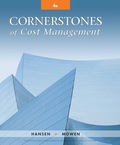
Baker, Inc., supplies wheels for a large bicycle manufacturing company. The bicycle company has recently requested that Baker decrease its delivery time. Baker made a commitment to reduce the lead time for delivery from seven days to one day. To help achieve this goal, engineering and production workers had made the commitment to reduce time for the setup activity (other activities such as moving materials and rework were also being examined simultaneously). Current setup times were 12 hours. Setup cost was $600 per setup hour. For the first quarter, engineering developed a new process design that it believed would reduce the setup time from 12 hours to nine hours. After implementing the design, the actual setup time dropped from 12 hours to seven hours. Engineering believed the actual reduction was sustainable. In the second quarter, production workers suggested a new setup procedure. Engineering gave the suggestion a positive evaluation, and they projected that the new approach would save an additional six hours of setup time. Setup labor was trained to perform the new setup procedures. The actual reduction in setup time based on the suggested changes was four hours.
Required:
- 1. What kaizen setup standard would be used at the beginning of each quarter?
- 2. Describe the kaizen subcycle using the two quarters of data provided by Baker.
- 3. Describe the maintenance subcycle for setups using the two quarters of data provided by Baker.
- 4. How much non-value-added cost was eliminated by the end of two quarters? Discuss the role of kaizen costing in activity-based management.
- 5. Explain why kaizen costing is compatible with activity-based responsibility accounting while
standard costing is compatible with financial-based responsibility accounting.
Trending nowThis is a popular solution!

Chapter 12 Solutions
EBK CORNERSTONES OF COST MANAGEMENT
- Bucket's opereting leverage??? General accountingarrow_forwardNonearrow_forwardThe predetermined overhead rate for RON Company is $10, comprised of a variable overhead rate of $6 and a fixed rate of $4. The amount of budgeted overhead costs at a normal capacity of $300,000 was divided by the normal capacity of 30,000 direct labor hours, to arrive at the predetermined overhead rate of $10. Actual overhead for July was $40,000 variable and $28,200 fixed, and the standard hours allowed for the product produced in July was 7,000 hours. The total overhead variance is: A. $6,100 U B. $1,100 U C. $500 U D. $1,800 Farrow_forward
 Cornerstones of Cost Management (Cornerstones Ser...AccountingISBN:9781305970663Author:Don R. Hansen, Maryanne M. MowenPublisher:Cengage Learning
Cornerstones of Cost Management (Cornerstones Ser...AccountingISBN:9781305970663Author:Don R. Hansen, Maryanne M. MowenPublisher:Cengage Learning
